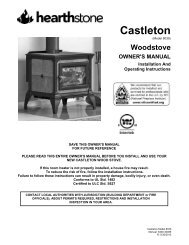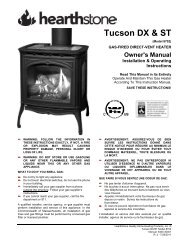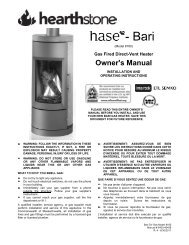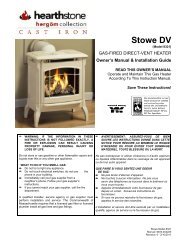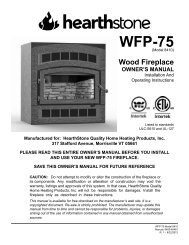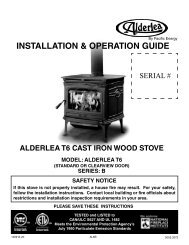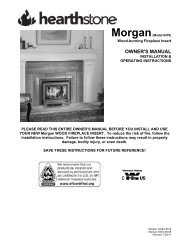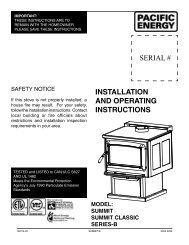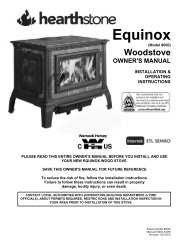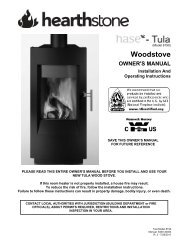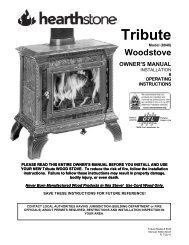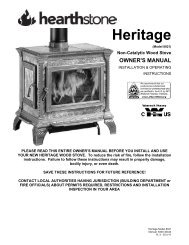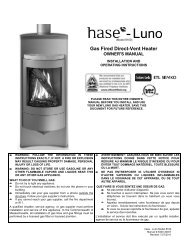Clydesdale 8491 Manual - Hearthstone Stoves
Clydesdale 8491 Manual - Hearthstone Stoves
Clydesdale 8491 Manual - Hearthstone Stoves
Create successful ePaper yourself
Turn your PDF publications into a flip-book with our unique Google optimized e-Paper software.
<strong>Hearthstone</strong> <strong>Clydesdale</strong> Fireplace Insert Model <strong>8491</strong><br />
Maintenance<br />
Creosote Formation and Need for<br />
Removal<br />
Wood, when burned slowly, produces tar and other<br />
organic vapors, which combine with expelled<br />
moisture to form creosote. These creosote vapors<br />
condense in the relatively cool chimney flue of a<br />
slow-burning fire. As a result, creosote residue<br />
accumulates on the flue lining. When ignited, this<br />
creosote makes an extremely hot fire, which may<br />
damage the chimney or even destroy the house.<br />
Inspect the flue liner and chimney at least once every<br />
month during the heating season to determine if there<br />
is a creosote buildup.<br />
To prevent the buildup of creosote:<br />
1. Burn the Fireplace Insert with the primary air<br />
control fully open for 20 - 40 minutes daily to<br />
burn out creosote deposits from within the<br />
Fireplace Insert and the venting system.<br />
2. After reloading with wood, burn the Fireplace<br />
Insert with the primary air control fully open<br />
for 20 to 30 minutes. This manner of<br />
operation ensures early engagement of the<br />
secondary combustion system which, when<br />
engaged, minimizes creosote buildup in the<br />
chimney.<br />
If a creosote residue thicker than 1/4" (6 mm)<br />
accumulates, remove it to reduce the risk of a<br />
chimney fire.<br />
If your glass always remains dirty, your operating<br />
temperatures are probably too low, or your wood is<br />
not dry enough; therefore, there is a higher risk of<br />
creosote buildup.<br />
Inspect the venting system for creosote at the Insert<br />
connection and at the chimney’s top. Cooler<br />
surfaces tend to build creosote deposits faster, so it<br />
is important to check the chimney at the top (where it<br />
is coolest) as well as from the bottom at the Insert.<br />
Remove accumulated creosote with a cleaning brush<br />
specifically designed for the type of chimney in use.<br />
Use a certified chimney sweep to perform this<br />
service. Contact your dealer for the name of a<br />
certified chimney sweep in your area (your dealer<br />
may be a certified sweep!).<br />
We recommend that you have the entire system<br />
professionally inspected, cleaned, and repaired if<br />
necessary, before each heating season.<br />
Gaskets<br />
Depending on use, replace gasket materials every<br />
two to three seasons. If the door seal is leaking, a<br />
new gasket will assure a tight seal and improved<br />
performance. Contact your dealer for a gasket kit<br />
that includes instructions and gaskets for your<br />
Fireplace Insert.<br />
To replace the door gasket, first remove the old<br />
gasket with a utility or putty knife. Clean all gasket<br />
channels with a wire brush. Apply gasket cement to<br />
the channels and push the new gasket into place<br />
without stretching the gasket material. Immediately<br />
close the door to fully press the gasket into place and<br />
assure a positive seal.<br />
Glass<br />
Do not operate the Fireplace Insert with a broken<br />
door glass. Do not abuse the front door by striking or<br />
slamming.<br />
When necessary, clean the glass with low alkaline<br />
content commercial stove glass cleaners, which are<br />
available from your local dealer. Never attempt to<br />
clean the glass while the fire is burning, or if the glass<br />
is hot. Most deposits are easily cleaned by following<br />
the instructions provided with the cleaner. To clean<br />
heavier deposits, remove the door from the Fireplace<br />
Insert (take care to save hinge pins and spacers for<br />
reuse). Lay the door face down on a workbench or<br />
table with the handle hanging over the edge. Apply<br />
the cleaner to the glass and allow it to sit for a few<br />
minutes. Placing the door flat, it will allow the cleaner<br />
to penetrate rather than running off the surface of the<br />
glass. Wipe the cleaner off with a soft cloth.<br />
Important: scratching or etching the glass<br />
will weaken the integrity of the glass. Do not<br />
use a razor blade, steel wool, or any other<br />
abrasive material to clean the glass. Use low<br />
alkaline content cleaners only.<br />
The front door glass is a ceramic, shock-resistant<br />
glass, made specifically for use in woodstoves. Do<br />
not use any replacement glass other than the<br />
ceramic glass manufactured and supplied for use in<br />
this woodstove. Replacement glass is available<br />
through your local dealer.<br />
Replace the door glass immediately if broken.<br />
Contact your local dealer for a replacement glass kit.<br />
The glass kit comes with instructions and everything<br />
Page 26 of 33



